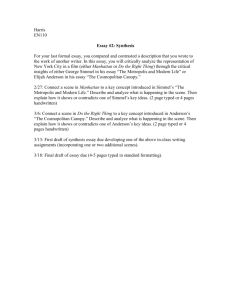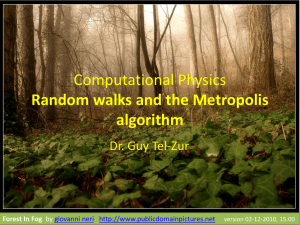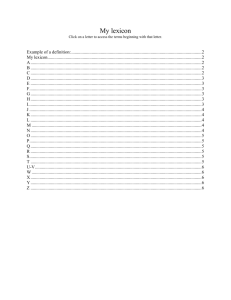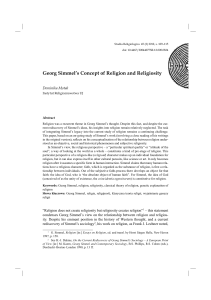Essays 3 and 4 - English 110: New York City
advertisement
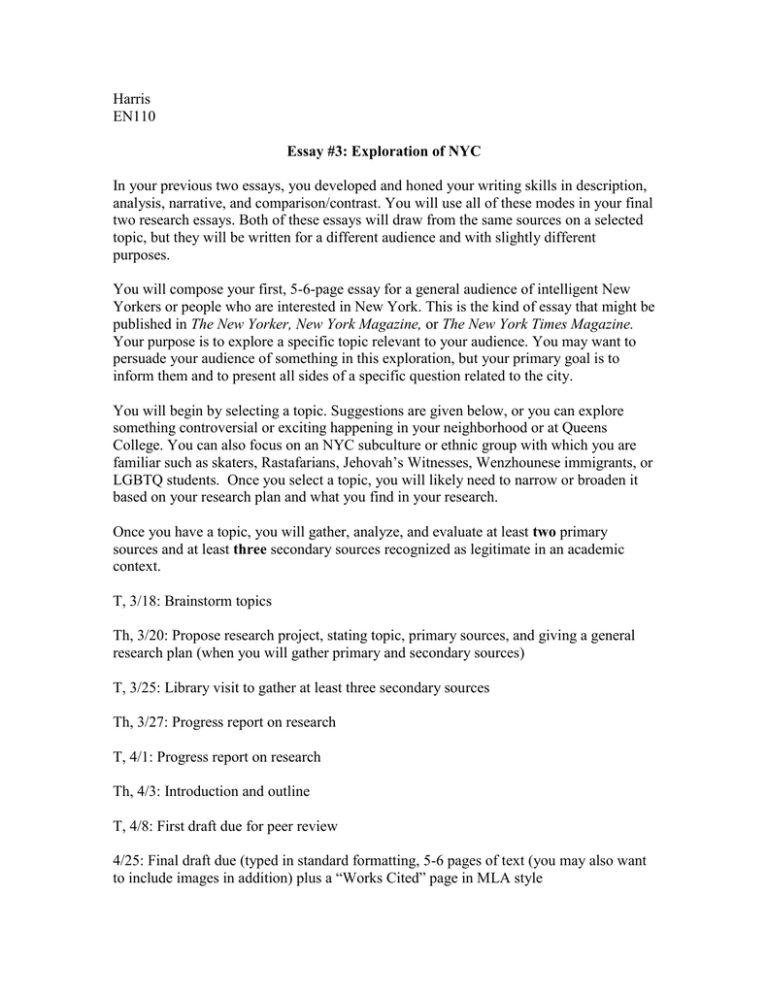
Harris EN110 Essay #3: Exploration of NYC In your previous two essays, you developed and honed your writing skills in description, analysis, narrative, and comparison/contrast. You will use all of these modes in your final two research essays. Both of these essays will draw from the same sources on a selected topic, but they will be written for a different audience and with slightly different purposes. You will compose your first, 5-6-page essay for a general audience of intelligent New Yorkers or people who are interested in New York. This is the kind of essay that might be published in The New Yorker, New York Magazine, or The New York Times Magazine. Your purpose is to explore a specific topic relevant to your audience. You may want to persuade your audience of something in this exploration, but your primary goal is to inform them and to present all sides of a specific question related to the city. You will begin by selecting a topic. Suggestions are given below, or you can explore something controversial or exciting happening in your neighborhood or at Queens College. You can also focus on an NYC subculture or ethnic group with which you are familiar such as skaters, Rastafarians, Jehovah’s Witnesses, Wenzhounese immigrants, or LGBTQ students. Once you select a topic, you will likely need to narrow or broaden it based on your research plan and what you find in your research. Once you have a topic, you will gather, analyze, and evaluate at least two primary sources and at least three secondary sources recognized as legitimate in an academic context. T, 3/18: Brainstorm topics Th, 3/20: Propose research project, stating topic, primary sources, and giving a general research plan (when you will gather primary and secondary sources) T, 3/25: Library visit to gather at least three secondary sources Th, 3/27: Progress report on research T, 4/1: Progress report on research Th, 4/3: Introduction and outline T, 4/8: First draft due for peer review 4/25: Final draft due (typed in standard formatting, 5-6 pages of text (you may also want to include images in addition) plus a “Works Cited” page in MLA style Other Possible Topics The recent destruction of 5Pointz in Long Island City The aftermath of Hurricane Sandy in various NYC neighborhoods Street harassment in New York City Homelessness in New York City Rent control in New York City Future plans for Willett’s Point You can also consult the “New York” section of The New York Times for ideas. Primary and Secondary Sources Primary: Observations, Interviews, Participant Blogs, Participant Web Sites, Participant Emails, Participant Letters, Participant Diaries, Archives Secondary: Articles, Books, Documentary Films Harris EN110 Prompts for 2/27 Writing Assignment 1) In “The Metropolis and Modern Life,” Georg Simmel claims that the city promotes individuality and freedom. At the same time, living in the city makes one dependent on others who live in the city and on the city itself. Describe a scene in which Woody Allen represents this individualism in Manhattan and a scene that shows a character’s dependence on the city or on others (this might be the same scene). 2) Describe one or two scenes in Manhattan in which the city itself is shown influencing character reactions or interactions. How do these scenes represent the city? Do they show the city influencing the “blasé” or rational attitude in people that Simmel describes? Explain your response. 3) Simmel notes that “people of the city become more specialized and divided” (1718). How would you describe the population of New Yorkers Allen shows us in Manhattan? Focus on a specific scene to support your point. What aspects of New York City do you think he leaves out of his film in concentrating on this group? Guide to Simmel, “The Metropolis and Modern Life” Below are listed Georg Simmel’s key ideas in “The Metropolis and Modern Life.” 1) The city-dweller is more intellectual and rational than someone in a small town (11-13). As Simmel writes, “Instead of reacting emotionally, the metropolitan type reacts primarily in a rational manner . . . . Thus the reaction of a metropolitan person to these events is moved to a sphere of mental activity which is least sensitive and which is furthest removed from the depths of the personality” (12). 2) The city-dweller has a “blasé” attitude (14-15). “This incapacity to react to new stimulations with the required amount of energy constitutes in fact that blasé attitude which every child of a large city evinces when compared with the products of a more peaceful and more stable milieu” (14). 3) The city-dweller is reserved in public (15). “The mental attitude of the people of the metropolis to one another may be designated formally as reserve” (15). 4) The city-dweller has more freedom than someone in a small town (16). “It is obviously only the obverse of this freedom that one never feels as lonely and as deserted as in this metropolitan crush of persons” (16). 5) The city goes beyond its own limits. It becomes global, not just local (17). “For in the metropolis it is decisive that its inner life is extended in a wave-like motion over a broader national or international area” (17). 6) At the same time, the people of the city become more specialized and divided (17-18). “Exactly in the measure of its extension, the city offers to an increasing degree the conditions for the division of labor” (17). 7) In response to the conformity of the city, the city-dweller becomes more individualistic than someone who lives in a small town (18-19). “As a result, in order that this most personal element be saved, extremities and peculiarities and individualizations must be produced and they must be over-exagerrated merely to be brought into the awareness even of the individual himself” (19). Hints for Writing about Film: First, make sure you are describing the scene correctly. If possible, watch it several times. Write down key points of dialogue, what you see in the scene (the mise-en-scene) and how the shots fit together. Note how this scene relates to other scenes in the film. What patterns does it follow? Where does it differ? Make sure you are writing the characters’ and actors’ names correctly. You can double check this online at IMDB (http://www.imdb.com). Prompts for 3/6 Writing Assignment 1) In “The Cosmopolitan Canopy,” Elijah Anderson focuses on specific areas of Philadelphia—Reading Terminal Market, a jazz club—that he calls “cosmopolitan canopies,” places “which no one group expressly owns but all encouraged to share, situated under this kind of protective umbrella” (22). Are the streets of Bed-Stuy as shown in Do the Right Thing a “cosmopolitan canopy” as defined by Anderson? Why or why not? Defend your response by referring to a specific scene or scenes. 2) While it caters to a diverse community, Sal’s pizza place is not a “neutral social setting” as described by Anderson in “The Cosmopolitan Canopy.” What tensions in the community make it non-neutral? Why do you think Mookie smashes Sal’s window in the conclusion? 3) Elijah Anderson begins his essay by complicating Simmel’s ideas of the metropolis, showing how the city is “more racially, ethnically, and socially diverse than ever, with profound cleavages dividing one element from another and one social group from another” (15). Give a specific example from Do the Right Thing that supports Anderson’s point. How does this make the film different from a film that focuses on one group of New Yorkers like Manhattan?
